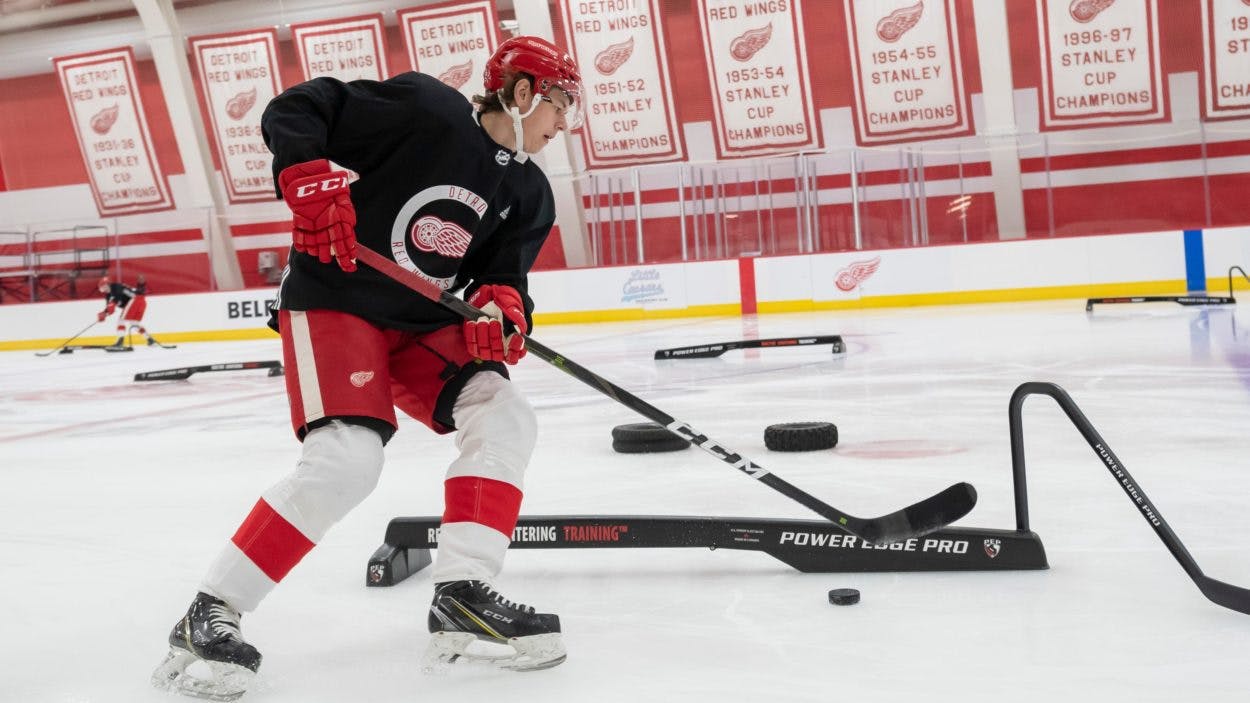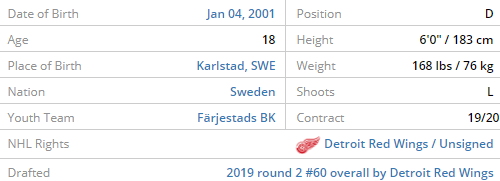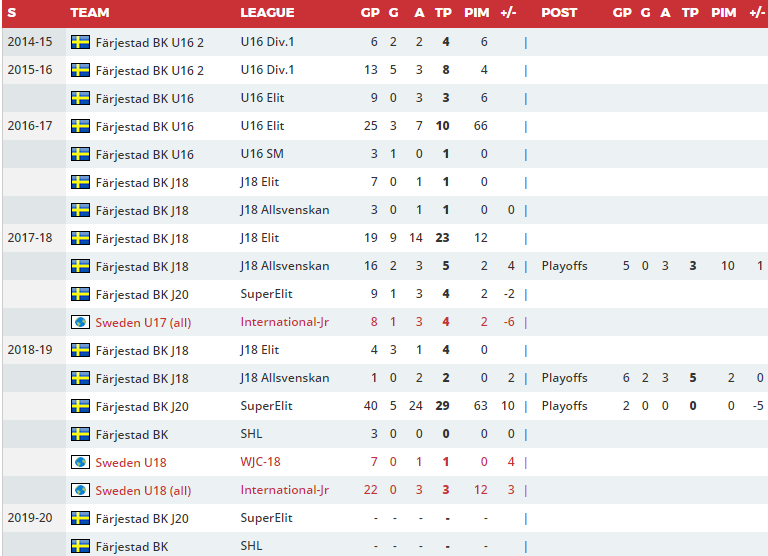Top 25 Red Wings Prospects of 2019: #17 Albert Johansson

By Tony Ferrari
4 years agoWith three second round picks in the 2019 NHL draft, the Detroit Red Wings were able to add a solid stable of prospects to their growing stockpile. The third of those choices was left-handed defenceman Albert Johansson. The Swedish blue-liner is an effective puck mover and a fluid skater who played primarily at the SuperElit level last season in his native Sweden. Johansson did get a cup of coffee at the SHL (Top men’s Swedish league) having played three games with limited results.

The choice to take Johansson with the 60th pick in the draft was a good one for general manager Steve Yzerman and the Wings management team. Ranked 46th by Future Considerations and 64th by Dobber Prospects, he was selected well within his expected range. The 6’0″ defender filled both the need for defencemen in the organization and was also among a group of players that could reasonably be considered the best player available at the time.
Overview

Image courtesy of Elite Prospects
Career Arc
The second round pick from this past June has been in the Färjestad BK organization since his 2014-15 when he was playing in the U16 age group at the age of 13. He has grown and developed on pace with each new level. He played parts of each of the last two seasons in the SuperElit, Sweden’s top junior U20 league. He excelled while playing in the SuperElit with 29 points in 40 games. This production was good enough to earn him a spot with the top-level Färjestad BK team in the SHL, Sweden’s top league. His brief cup of coffee at the SHL level lasted only three games but the experience was valuable nonetheless.

Statistics table provided by Elite Prospects.
His international career has been fairly limited up until this past season. Prior to this year he only had eight games of international experience, all coming in 2017-18 at the U17 level. This past season he played in a number of international events and games but the most significant came in at the U18 World Championships where he helped Sweden win the gold medal. He wasn’t a major member of the team but the Swedes’ had a very strong team this year. Playing primarily on the third pair, he was often paired with Victor Soderstrom (Arizona Coyotes) or Ludvig Hedstrom (undrafted). His play was steady in the limited role and he played and he did assist on the gold medal winning goal in overtime. Below you can see Johansson (#3) make a short pass at the point that is sent across the ice to Lucas Raymond, a unanimous top-five prospect for the 2020 draft at the moment.
Player Profile
To best analyze and evaluate a player, we will go through a series of videos that were clipped from videos that are courtesy of Prospect Shifts. We will look at various aspects of his game defensively, offensively and in transition. Looking at both where he excels and needs work, the following videos will aid in fully understanding who Albert Johansson is as a player.
As a defenceman, the logical place to begin analyzing Johansson is his play in his own zone. In the video above, we see Johansson (#92) highlighted to begin the clip, while playing for Färjestad BK U20 team last season. With the opposing player coming into the zone with speed, we see Johansson step up as he crosses the blue line and engage the forward physically, separating the man from the puck. This allows his defensive partner to chase the puck into a corner with the inside position. When Johansson recognizes that his partner is following the puck into the corner he fades back to protect the net replacing his partners position. This allows the puck to be cleared to a forward high in the zone. Johansson displays good gap control by closing in on the attacking player and defensive awareness in his positioning after disengaging with the forward.
The next video, below, is an example of Johansson’s ability to transition from defense to offence. While with the Swedish National U18 Team, Johansson (#3) played a third pairing role with offensive zone starts and secondary power play time for the most part. Here we see Johansson do an excellent job of staying in front of the opposing forward preventing a clean shot. The puck then finds itself in the corner, recovered by Johansson’s defensive partner. After wheeling around the net a pass is made to Johansson. From the defensive zone Johansson does an excellent job of carrying the puck through the neutral zone, weaving around the opposition with good puck handling and above average skating. Johansson shows excellent transition play, a skill that every modern day defender ideally has.
The following video, again with the Swedish U18 team, we see Johansson identify that he can be aggressive and attack the puck carrier at center ice. This leads to a loose puck, recovered by Johansson’s teammate who immediately identifies that Johansson has followed his own defensive play and can carry the puck into the offensive zone with speed and momentum in his favour. This leads Johansson below the circles where he stops up before getting into the corner. This creates space for the young left-handed defender who attempts to fire a pass to the back-side of the net for a waiting forward before the goaltender breaks up the pass. Although this play doesn’t lead to a goal, it shows that Johansson has the ability to be aggressive when defending, cutting the play off before it had the opportunity to even enter Johannson’s defensive zone.
The following video shows Johansson (#3) pinching in from the point to corral a loose puck. He ends up in a battle along the boards and he can be seen communicating with teammates to regain possession of the puck. Once Johansson feels that his forward has engaged the puck he begins to disengage and fade into open space. There he receives a pass and makes a move to the middle of the ice, making a backhand pass to an open point. Johansson peels off towards the blue line, re-positioning himself along the point. Having a blue liner engage along the boards and ensure that the puck stays in the offensive zone eliminates the time that a team is left to defend their own net. Puck possession is a key part in controlling a game.
No player is perfect. Even Nick Lidstrom made mistakes and Johansson (#92 in the video below) is certainly no Lidstrom. Although it led to nothing, the play below shows Johansson attempt to halfheartedly challenge the offensive player at the blue line. When he fails to fully commit to the play, he is easily walked around and allows the offensive player ad the puck behind him. He is caught flat-footed and has difficulty recovering from the unfavourable position.
In the final video, we see Johansson make the smart play, jumping up to aid the forwards in the offensive zone. The problem arises when Johansson fails to make a decision with the puck. He takes a second too long and turns the puck over while he is at a standstill. This leads to a broken play at the other end of the ice that leads to a goal. Johansson is left to be the fourth man back without the ability to make a difference in his own end.
Johansson presents a good skill set. He displays good skating ability, with and without the puck. His edge work is above average and he is able to change direction quickly, adjusting to the play and regain position. Defensively, he does a good job at cutting down his gaps more often than not. He can engage a play on the boards and he cuts out shooting and passing lanes using his skating to stay in front of a player. He sometimes gets beaten by more physical players, he will need to continue to get stronger as he matures.
His puck skills allow him to be a reliable transitional player who can move the puck up the ice with either his skating or a pass to a forward. Inconsistency sometimes pops up into his game, he needs to learn to limit the mistakes by making decisions quicker at times. He does an excellent job of staying elusive in the neutral zone and entering the zone with control of the puck. His transition game is one of his biggest strengths.
In the offensive zone, Johansson has a good shot that gets through to the net at a good rate because of his ability to laterally skate the blue line, opening up a shooting lane for himself. He does an effective job of distributing the puck. He makes crisp passes and seldom makes an egregious error from high in the zone. When pinching in the zone, he is at his best when staying in the circles and away from the corners. When below the red line, he can panic and pin the puck to the boards, stagnating himself deep in the offensive zone, exposing his team to defensive lapses. If he can make efficient decisions a bit quicker, he can develop into a solid offensive contributor.
Why Johansson is 18th on the List/Future Projection.
The Red Wings have quietly begun to collect a solid stable of lottery ticket defencemen. With top-end defensive prospects like Moritz Seider, Jared McIsaac, and Gustav Lindstrom along with what should be NHL regulars Filip Hronek and Dennis Cholowski, Johansson fits into the next wave. Players like Alec Regula, Kasper Kotkansalo and Seth Barton are around the same range as Johansson. Johansson doesn’t possess the high-end offensive ability of Hronek or Cholowski and hes isn’t as well rounded as Seider or McIssac. He has tools that would allow him to be that kind of player, he just needs to further mature with his decision making and become a more consistent performer. The raw tools he possesses helps put him atop the “next wave” group of blue line prospects.
The 2019 second round pick is a couple of years away. He will spend next season in the SHL, with the next step coming based on how his first full SHL season plays out. If he shows that he is unable to perform at the men’s level in Sweden, he could be sent down to the SuperElit again and play games in the Swedish junior league. With this being the worst case scenario, it would push his estimated time of arrival back an additional year. However, if the season goes as hoped and Johansson can stick in the SHL for the duration of the season, Johansson will need to make a decision after next season. He could play an additional year in Sweden before coming over to North America before attempting to compete for a spot. If he decides to come to North America after a successful first SHL seaosn, he would likely take on a large role with the AHL’s Grand Rapids Griffins, acclimating himself to the North American pro game a year sooner.
In the best case scenario, after a successful year in the SHL, Johansson excels in an AHL top-four role and then joins the Red Wings on the bottom pair, eventually becoming a possible number four defenceman with some puck-moving ability. The worst case scenario would be that Johansson fails to adapt to the SHL game over the next couple pf seasons and doesn’t come to North America for more than a long shot, short AHL stint before returning home to Sweden. Johansson is an interesting prospect who will have a good chance to shoot up the rankings next season as one of the rising prospects the Red Wings have. This season in the SHL will go a long way as to determining how valuable an asset that Johansson projects to be long-term. Only time will tell whether the young Swede can turn his potential into performance, but the skills are there to be a modern day NHL defender.
Recent articles from Tony Ferrari





